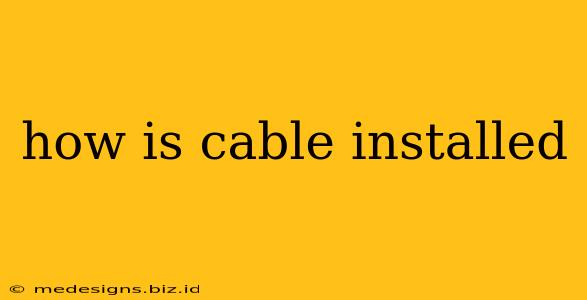So, you've decided to get cable TV? Excellent choice! But before you can start enjoying your favorite shows, you'll need to understand how cable installation works. This comprehensive guide will walk you through the entire process, from the initial contact to the final connection.
Understanding the Cable Installation Process
Cable TV installation isn't as simple as plugging in a device. It involves a series of steps, requiring specialized equipment and expertise. The process generally looks like this:
1. Scheduling Your Installation Appointment
The first step is contacting your chosen cable provider. They'll schedule a professional technician to come to your home. Be sure to provide accurate details about your address and availability to ensure a smooth scheduling process. This usually involves choosing a specific day and time window that fits your schedule.
2. The Technician's Arrival and Initial Assessment
When the technician arrives, they'll conduct a brief assessment of your home's infrastructure. This includes checking your existing wiring, identifying the best location for the cable box and modem, and determining the optimal path for the cable line.
3. Running the Cable Line (New Installations)
For new installations, the technician might need to run a new coaxial cable from the nearest cable junction or street box to your home. This often involves drilling small holes in exterior walls or running the cable along existing pathways. They'll ensure the cable is securely fastened and protected from damage.
Important Note: For existing homes, the technician will utilize pre-existing cabling if possible. This usually speeds up the process considerably.
4. Connecting the Cable Box and Modem
Once the cable line is connected to your home, the technician will connect your cable modem and set-top box. This involves connecting coaxial cables, power cables, and potentially ethernet cables depending on your setup (for internet service). They'll ensure all connections are secure and functioning correctly.
5. Testing and Activation
After making the connections, the technician will perform a series of tests to ensure everything is working as expected. This includes checking signal strength, channel availability, and internet speed (if applicable). Once everything passes, they'll activate your service.
6. Final Walkthrough and Explanation
Finally, the technician will walk you through how to operate your equipment, explaining the different features and functionalities of your cable box and remote. They'll also answer any questions you may have and provide contact information in case of future issues.
What to Expect During Cable Installation
- Time: The installation process can take anywhere from one to several hours, depending on the complexity of the setup.
- Access: The technician will need access to your home's exterior and interior walls to complete the installation.
- Clean Up: Reputable cable companies ensure technicians leave your property clean and tidy. Any minor damage caused during installation should be repaired.
Troubleshooting Common Cable Installation Issues
Sometimes, unexpected issues can arise during cable installation. Here are a few common problems and their potential solutions:
- Weak Signal: A weak signal often indicates a problem with the coaxial cable connection or external factors affecting the signal. Contact your provider for assistance.
- No Signal: This could result from a faulty cable box, modem, or a problem with the main cable line. Contact your provider's technical support immediately.
- Intermittent Service: Intermittent service might be due to loose connections or weather conditions affecting the signal. Check all connections and contact your provider.
Choosing the Right Cable Provider
Selecting the right cable provider is crucial for a smooth and satisfying experience. Consider factors like:
- Pricing and Packages: Compare the different packages offered by various providers to find one that fits your budget and viewing habits.
- Customer Service: Read online reviews to get an idea of each provider's customer service reputation.
- Channel Lineup: Make sure the provider offers the channels you want to watch.
- Internet Options: If you're looking for bundled internet and cable packages, compare the internet speeds and data caps.
By following these steps and understanding the common issues, you can ensure a smooth and successful cable TV installation. Remember to contact your cable provider if you have any questions or concerns during or after the installation process.
